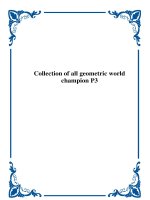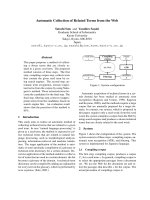COLLECTION of ARTICLESPAPERS HYSTEROSALPINGOGRAPHY
Bạn đang xem bản rút gọn của tài liệu. Xem và tải ngay bản đầy đủ của tài liệu tại đây (15.37 MB, 112 trang )
COLLECTION of
ARTICLES/PAPERS
HYSTEROSALPINGOGRAPHY
Collected by @Serv12
CONTENTS
HYSTEROSALPINGOGRAPHY
1. Hysterosalpingography (HSG) anatomy, imaging and pathology
revisited
2. Hysterosalpingography: Spectrum of Normal Variants and
Nonpathologic Findings
3. Hysterosalpingography: A Reemerging Study
4. Hysterosalpingography: Technique and Applications
5. Hysterosalpingography in Infertility
6. Hysterosalpingography and investigation of female infertility
7. Balloon Catheter Hysterosalpingography by Stephen D. Sholkoff
8. Balloon Catheter Hysterosalpingography by Isabel C. Yoder and
Richard C. Pfister
9. Hysterosalpingography and Sonohysterography: Lessons in
Technique
10. Virtual Hysterosalpingography: A New Multidetector CT Technique
for Evaluating the Female Reproductive
11. A Hybrid Radiography/ MRI System for Combining
Hysterosalpingography and MRI in Infertility Patients: Initial
Experience
12. MR Hysterosalpingography with an Angiographic Time-Resolved 3D
Pulse Sequence: Assessment of Tubal Patency
13. Hysterosalpingography and Laparoscopy in Evaluating Fallopian
Tubes in the Management of Infertility in Cotonou, Benin Republic
Collected by @Serv12
Hysterosalpingography (HSG) anatomy, imaging and
pathology revisited
Poster No.:
C-335
Congress:
ECR 2009
Type:
Educational Exhibit
Topic:
Genitourinary
Authors:
A. M. Browne, E. DeLappe, H. Khosa, G. Colleran, K. Cronin, C.
Roche; Galway/IE
Keywords:
uterus, Genitourinary, Hysterosalpingography, fallopian tubes
DOI:
10.1594/ecr2009/C-335
Any information contained in this pdf file is automatically generated from digital material
submitted to EPOS by third parties in the form of scientific presentations. References
to any names, marks, products, or services of third parties or hypertext links to thirdparty sites or information are provided solely as a convenience to you and do not in
any way constitute or imply ECR's endorsement, sponsorship or recommendation of the
third party, information, product or service. ECR is not responsible for the content of
these pages and does not make any representations regarding the content or accuracy
of material in this file.
As per copyright regulations, any unauthorised use of the material or parts thereof as
well as commercial reproduction or multiple distribution by any traditional or electronically
based reproduction/publication method ist strictly prohibited.
You agree to defend, indemnify, and hold ECR harmless from and against any and all
claims, damages, costs, and expenses, including attorneys' fees, arising from or related
to your use of these pages.
Please note: Links to movies, ppt slideshows and any other multimedia files are not
available in the pdf version of presentations.
www.myESR.org
Page 1 of 16
Learning objectives
1) To provide a brief overview of the technique of Hysterosalpingography.
2) To discuss the indications for and complications of HSG.
3) To illustrate the characteristic appearances of HSG pathology and
differentiate these from other pathologies where appropriate
Background
Hysterosalpingography (HSG) is the radiographic evaluation of the uterus
and fallopian tubes with the use of radiographic contrast medium.
The number of HSG examinations has increased in recent years. This is
likely to be due to advances in in vitro fertilization procedures and the trend
towards women delaying pregnancy until later in life(1,2).
Indications for HSG
The most common indications for performing HSG are
•
•
•
•
•
infertility
recurrent spontaneous abortion
recurrent preterm delivery
evaluation of the uterus and fallopian tubes post tubal surgery
preoperative evaluation of the uterus prior to surgery
HSG Technique
• The examination is scheduled for days 6-10 of the menstrual cycle.
• The patient is instructed to abstain from sexual intercourse from the day 1
of the menstrual cycle to avoid irradiating a potential pregnancy.
• The patient is placed supine on the fluoroscopy table in the lithotomy
position.
• The area is prepared with povidone-iodine solution(betadine) and draped
with sterile towels.
Page 2 of 16
• A speculum is placed into the vagina and the cervix is localised.
• A 5-F HSG catheter is positioned into the cervical os and canal and the
balloon is inflated.
• Water-soluble contrast material is slowly instilled under fluoroscopic
guidance with intermittent images obtained to evaluate the uterus and
fallopian tubes.
Pain relief
A recent cochrane review (2007) found little evidence for the benefit of
pain relief administered duirng or immediately after HSG. There is limited
evidence of pain reduction with any administered analgesia 30 minutes after
the procedure(3).
Contraindications to HSG
Contraindications to HSG include;
•
•
•
•
pregnancy
current pelvic infection
active menses
recent uterine surgery
Complications
Complications include;
• Bleeding and infection (<3%) are the two most common infections. Patients
should be instructed that if they notice foul smelling vaginal discharge or
become feverish days after the procedure they should attend their primary
doctor and receive antibiotic therapy.
• Many patients have light spotting after the procedure
• Some patients may experience cramping during and after the procedure
which can be due to uterine distension and irritation of the peritoneal cavity
due to contrast
• Contrast media reaction is very rare especially with the use of low-osmolar
nonionic contrat agents.
Page 3 of 16
• Lymphatic (fig. 1) on page
or vascular intravasation (fig.2) on page
is clinically insignificant and not dangerous(1).
• Perforation of the uterus or fallopian tubes is extremely rare and usually
presents with increasing abdominal pain.
• Irradiation of an early, unsuspected pregnancy is possible but timing of the
examination in the menstrual cycle should avoid this (fig. 3) on page
.
Images linked within the text of this section:
Page 4 of 16
Fig.: Spot radiograph of HSG showing vascular intravasation of contrast(yellow arrows).
Fig.: Spot radiograph shoiwng lymphatic intravasation(yellow arrow). There is also a left
fallopian tube clip(blue arrow).
Page 5 of 16
Fig.: Spot radiograph of HSG demonstrating an intrauterine pregnancy.
Page 6 of 16
Imaging findings OR Procedure details
Information obtained from HSG includes
•
•
•
•
•
•
the width of the cervical canal
the contour of the uterine cavity
the orientation of the uterus - anteverted(fig. 4) on page
retroverted
an outline of the lumen of the fallopian tubes and cornua
the presence or abscence of spillage of contrast from the
fimbriated ends of the tubes.
an outline of peritoneal structures.
/
UTERUS
The size of the uterus varies depending on the patients age and parity. HSG
is only helpful in the evaluation of the uterine cavity.
At HSG, the uterus should resemble an inverted triangle with well-defined
smooth contours .
Congenital Uterine Abnormalities
Congenital abnormalities of uterine shape are due to abnormal fusion of the
mullerian ducts during early (6-12 weeks)gestation(4).
•
A Unicornuate uterus is due to complete or almost complete
arrested development of one mullerian duct. Incomplete arrest of
development is present in 90% of patients. It may be associated
with a rudimentary horn arising from the contralateral mullerian
duct .
•
A Didelphys uterus is due to complete nonfusion of the mullerian
ducts. Usually 2 cervices are present. The individual horns
are fully developed and almost normal in size. A longitudinal
or transverse vaginal septum may be present. Patients
with didelphys uterus have been known to carry full term
pregnancies(fig. 7) on page
.
•
A T shaped uterus is associated with in-utero
diethylstilbestrol(DES) exposure. Typically the uteri are
Page 7 of 16
hypoplastic. The T-shaped uterine cavity is due to myometrial
hypertrophy(fig. 8) on page
.
•
A Bicornuate uterus is due to partial failure of fusion of the
mullerian ducts. It is distinguished from didelphys uterus, as
it demonstrates some degree of fusion between the 2 horns
whereas in didelphys uterus, the 2 horns and cervices are
completely separated. The horns of bicornuate uteri are not fully
developed and are typically smaller than in didelphys uterus(, ).
•
A Septate uterus is due to failure of resorption of the medial
septum. THe sseptum can be partial or complete. The septum
can be of variable length and can be formed from myometrium
or fibrous tissue. Women with septate uterus have the highest
incidence of reproductive complications(fig. 11) on page
.
•
An Arcuate uterus has a single uterine cavity with a flat or convex
uterine fundus. It is considered to be a normal variant(fig. 12) on
page
.
Filling defects within the lumen
• The catheter should be flushed well with contrast material to avoid injecting
air bubbles.
• Air bubbles are demonstrated as well-circumscribed, mobile lucencies that
collect in the nondependent portion of the uterus.
• Synechiae are demonstrated as irregular filing defects. Multiple synechiae
associated with infertility are known as asherman syndrome.
Abnormalities of Uterine Contour
• Fibroids or leiomyomas are benign tumours of the smooth muscle of the
uterus. They can be subserosal, intramural or submucosal within the uterine
wall. They are demonstrated as well-defined filling defects at HSG().
•Endometrial polyps appear as smooth walled filling defects arising from the
uterine wall and protruding into the uterine lumen ().
•Caesarian section scars appear as a linear irregularity at the isthmic portion
of the lower uterine segment(). Occasionally a caesarean section scar may
appear as a wedge-shaped outpouching or diverticulum.
Page 8 of 16
Fallopian Tubes
Fallopian tubes allow the ovum to travel from the ovary to the uterus. They
are 10-12cm in length and are situated in the superior aspect of the broad
ligaments.
The Fallopian tubes vary in location within the pelvis and degree of
tortuousity. They consist of cornual, isthmic and ampullary portions of
fallopian tube().
HSG is the best method for evaluating and imaging the fallopian tubes. At
HSG, the fallopian tubes should be identified as thin, smooth lines that widen
at the ampullary portion
Tubal abnormalities most commonly seen at HSG can be
•
•
•
•
congenital
due to spasm
occlusion
infection
Spasm
The cornual portion of the fallopian tube is surrounded by smooth muscle of
the uterus. If there is spasm of the muscle during HSG the fallopian tube will
not fill. This cannot be differentiated from tubal occlusion at HSG.
Antispasmodic agents (buscopan/glucagon) can relax smooth muscle and
lead to fallopian tube opacification(, ).
It is important to differentiate between tubal occlusion and tubal spasm as the
two entities can have very different impact on the patient's fertility treatment.
Infection
Pelvic inflammatory disease(PID) is the most common cause of tubal
occlusion leading to infertility.
Tubal occlusion is seen as a cut-off of contrast material with nonopacification
of the more distal fallopian tube. It can affect any portion of the fallopian tube
and be unilateral or bilateral(4)().
Page 9 of 16
If the blockage is in the ampullary portion, the tube may dilate leading to a
hydrosalpinx().
Peritubal adhesions most commonly manifest as loculation of contrast
material around the ampullary portion of the tube(4)().
Therapeutic effect of HSG
In addition the HSG also has therapeutic effect, which are associated with
increased fecundability in the months after the procedure(5).
Suggested mechanisms for this include, mechanically dislodging
substances (mucus, cells) obsructing the fallopian tubes, enhancing
endometrial receptivity, stimulating tubal cilia and thus enhancing the
transport of gametes, improving cervical mucus to enhance passage of
sperm and that iodine in the contrast medium has a bacteriostatic effect on
mucous membranes(5).
Future developments
64 slice MDCT has been used to image the uterus and fallopian tubes.This
technique reports to have a lower radiation dose, shorter procedure time and
lower level of discomfort for the patient (6).
It is however more costly. It also does not allow the direct visualization of
contrast while injecting the dye into the endometrial cavity. It does not have
the diagnostic and therapeutic potential of fluoroscopic HSG in patients with
proximal tubal occlusion, in allowing immediate tubal cannulation(6).
MR hysterosalpingographycan also be used to demonstrate the fallopian
tubes and uterus.
MRI can provide high-resolution images of the uterine cavity. Fallopian tube
clips can cause imaging artefact. It is not possible to perform MRI in some
patients i.e. patients with claustrophobila, pacemakers.
Page 10 of 16
Images linked within the text of this section:
Fig.: Spot radiograph of HSG showing an anteverted uterus.
Page 11 of 16
Fig.: Spot radiograph of HSG showing a septate uterus.
Page 12 of 16
Fig.: Spot radiograph of HSG demonstrating a T shaped uterus.
Page 13 of 16
Fig.: Spot radiograph of HSG demonstrating a didelphys uterus.
Page 14 of 16
Conclusion
HSG is a valuable imaging modality in the evaluation of the uterus and
fallopian tubes.
A wide variety of uterine and tubal abnormalities can be demonstrated with
hysterosalpingography.
Accurate diagnosis allows for early management of treatable conditions
including those affecting patient fertility.
We thus provide an interesting, informative and concise radiological guide
of HSG technique, anatomy and pathology.
Personal Information
References
1) Simpson WL, Beitia LG, Mester J. Hysterosalpingography: A reemerging
Study. Radiographics 2006; 26:419-431.
2) Troiano RN, McCarthy SM. Mullerian duct anomalies: imaging and clinical
issues. Radiology. Oct 2004;23-34.
3) Ahmad G, Duffy J, Watson AJS. Pain relief in hysterosalpingography.
Cochrane Database Syst Rev 2007; CD006106.
4) Ott DJ, Fayez JA.Tubal and adnexal abnormalities. In: Ott DJ, Fayez
JA,Zagoria RJ, eds. Hysterosalpingography:a text and atlas.2nd ed.
Baltimore,Md:Williams & Wilkins, 1998;90-93.
5) Johnson N, Vandekerckhove P, Watson A, et al. Tubal flushing for
subfertility. Cochrane Database Syst Rev 2005; CD003718.
6) Akaeda T, Isaka K, Nakaji T, Kakizaki D, Abe K. Clinical application
of virtual hysteroscopy by CO2-multidetector-row computed tomography
to submucosal myoma by virtual hysteroscopy. J Minim Invasive Gynecol
2005;12:261-6.
Page 15 of 16
Page 16 of 16
Downloaded from www.ajronline.org by 117.255.252.7 on 11/08/15 from IP address 117.255.252.7. Copyright ARRS. For personal use only; all rights reserved
Pictorial Essay
Hysterosalpingography: Spectrum of Normal Variants and
Nonpathologic Findings
Belén Úbeda 1, Marta Paraira, Enric Alert, Ramón Angel Abuin
H
ysterosalpingography is a valuable
technique in the evaluation of the infertile patient. During the last decade, the number of women seeking infertility
evaluation has increased considerably. Hysterosalpingography is considered a screening procedure for an infertility workup, and despite the
development of other diagnostic tools such as
MR imaging, hysteroscopy, and laparoscopy,
hysterosalpingography remains the main examination for the study of the fallopian tubes [1].
This technique provides useful, although indirect, information outlining the uterine cavity and
the fallopian tubes. Hysterosalpingography has
been reported to have a high sensitivity but a low
specificity, especially in the diagnosis of uterine
cavity abnormalities [2, 3]. The technical quality
of the hysterosalpingogram is important to limit
factors leading to misinterpretations. It is also es-
sential for the radiologist to be familiar with the
normal and abnormal radiologic findings for the
correct interpretation of hysterosalpingograms.
This pictorial essay describes and illustrates
the hysterosalpingographic appearances of
technical artifacts, normal variants, and findings with no proven influence on fertility.
Introduction of air bubbles can be prevented by
careful removal of air bubbles trapped in the
cannula. When present, air bubbles must be
eliminated by additional injection of contrast
material, which flushes them out of the uterine
cavity through the fallopian tubes (Fig. 1).
Venous or Lymphatic Intravasation
Technical Artifacts
Air Bubbles
During hysterosalpingography, air bubbles
can incidentally be introduced into the uterine
cavity and may be mistaken for other filling defects such as blood clots, polyps, submucosal
myomas, or endometrial hyperplasia. An air
bubble appears as a round, well-defined filling
defect; multiple air bubbles are often seen, and
they are usually identifiable by their mobility.
Venous or lymphatic intravasation can occur
in up to 6% of patients undergoing hysterosalpingography [4]. Although it can occur in
healthy patients, there are some predisposing
factors such as recent uterine surgery or increased intrauterine pressure because of tubal
obstruction or excessive injection pressure [2–4].
The radiographic appearance of early intravasation is characterized by filling of multiple thin beaded channels and an ascendant
course (Figs. 2 and 3). When intravasation is
Fig. 1.—Air bubbles in uterine horns of
29-year-old asymptomatic woman.
A, Hysterosalpingogram obtained with
balloon-catheter shows multiple
rounded filling defects (arrows), which
are mobile, at both uterine horns.
B, Hysterosalpingogram obtained
with additional injection of contrast
material shows bubbles have been
flushed out of uterine cavity through
fallopian tubes.
A
B
Received July 28, 2000; accepted after revision December 4, 2000.
1
All authors: Department of Radiology, Institut Universitari Dexeus, Pº Bonanova, 67 pl–2, 08017 Barcelona, Spain. Address correspondence to B. Úbeda.
AJR 2001;177:131–135 0361–803X/01/1771–131 © American Roentgen Ray Society
AJR:177, July 2001
131
Downloaded from www.ajronline.org by 117.255.252.7 on 11/08/15 from IP address 117.255.252.7. Copyright ARRS. For personal use only; all rights reserved
Úbeda et al.
Fig. 2.—Venous intravasation in healthy 28-year-old woman. Hysterosalpingogram
shows network of thin vessels (arrow) can be opacified during hysterosalpingography in healthy patients.
A
Fig. 3.—Venous intravasation in healthy 36-year-old woman. Hysterosalpingogram
obtained in patient with right isthmic tubal occlusion (short arrow) shows venous
intravasation of contrast material into myometrial vessels (long arrow).
B
C
Fig. 4.—Myometrial folds in 34-year-old woman.
A, Hysterosalpingogram shows broad longitudinal folds (arrows) parallel to uterine cavity that must be identified at early underfilled view of uterus.
B and C, Delayed radiographs obtained with larger volumes of contrast material show that contrast material progressively obliterates view of folds.
Fig. 5.—Double uterine contour (asterisk and arrows) in 30-year-old
woman. Hysterosalpingogram obtained during late secretory phase
of menstrual cycle shows double
uterine contour.
Fig. 6.—Double uterine contour in
34-year-old pregnant woman. Hysterosalpingogram was inadvertently
obtained in this patient who had
vaginal bleeding resembling menses
1 month before study. Hysterosalpingogram shows mildly enlarged
uterine cavity with double contour.
No gestational sac is evidenced.
5
132
6
AJR:177, July 2001
Downloaded from www.ajronline.org by 117.255.252.7 on 11/08/15 from IP address 117.255.252.7. Copyright ARRS. For personal use only; all rights reserved
Hysterosalpingography
recognized, the injection should be stopped
if an oil-soluble medium has been used.
Venous intravasation is innocuous as long as
a water-soluble contrast medium is used.
Controversy exists regarding the proper
choice of contrast material for hysterosalpingography. Some authors support the use of an
oil-soluble contrast medium, arguing that it provides greater contrast and sharpness of the image and more information about the presence of
peritubal adhesions [5]. An increase in pregnancy rates in infertile patients after hysterosalpingography with oil-soluble medium has
been suggested [6], whereas another study [7]
shows no statistical difference between the use
of oil- and water-soluble contrast agents.
Most authors advocate the use of a watersoluble contrast medium [2–4] because it provides better uterine and ampullary mucosal
detail and has no serious secondary effects
such as peritoneal inflammatory or granulomatous reaction and because it eliminates the risk
of pulmonary and retinal oil emboli. In addition, venous intravasation of water-soluble
contrast medium produces no adverse effects,
entering the vascular system and being excreted by the kidneys. Therefore, both diagnostic and safety factors recommend the use of
a water-soluble contrast medium.
Prominent Cervical Glands
The normal cervical canal is delineated by the
internal and external cervical os and can have
variable appearances depending on the patient
and the time in her cycle. The cervical canal is
usually narrower at the external and internal os
and wider in the midportion. The walls may be
smooth or serrated with longitudinal ridges representing the plicae palmatae. Sometimes, filling
of normal endocervical glands may be observed
as multiple tubular structures that originate from
both cervical walls (Fig. 7).
Findings with No Proven Influence on
Fertility
Arcuate Uterus
The arcuate uterus is usually an incidental
finding during hysterosalpingography, and it
appears as a mild smooth concavity in the
uterine fundus instead of the more common
straight or convex normal fundal contour (Fig.
8). According to the American Fertility Society’s classification, an arcuate uterus is considered a class VI müllerian anomaly [8].
Nevertheless, an arcuate uterus is such a minor
uterine malformation that it is considered a
normal variant and is not associated with infertility or obstetric complications [4, 8]. It must
be differentiated from the V-shaped fundus of
the subseptate uterus and from an extrinsic
compression caused by an intramural myoma.
Gartner’s Duct Cyst
Gartner’s duct is a remnant of the caudal portion of the mesonephric or wolffian duct that
fails to resorb normally in the female. Gartner’s
ducts can be single or multiple and are usually
located parallel to the anterior lateral wall of the
proximal third of the vagina [4]. Secretion by
persistent glandular tissue may allow cysts to
form in its course.
Gartner’s duct cysts may be visualized during
hysterosalpingography if they communicate with
the uterine lumen. These cysts are usually incidental findings with no clinical significance.
They appear as tubular structures that run parallel
to the uterine cavity or vagina, sometimes with
cystic or saccular dilatations (Figs. 9 and 10).
Infantile Uterus
The normal adult uterus can have variable
appearances, with a triangular-shaped uterine cavity and smooth margins. The uterine
Normal Variants
Myometrial Folds
In a small percentage of patients, broad
longitudinal folds parallel to the uterine cavity are seen on hysterosalpingograms with
otherwise normal findings (Fig. 4). These
folds are not associated with endometrial abnormalities. Although the exact etiology is
unknown, the folds are considered as remnants of the müllerian duct fusion during fetal development [4].
Fig. 7.—Prominent cervical glands
in 27-year-old woman. Hysterosalpingogram with normal findings
shows tubular-shaped structures
(arrows) originating from cervical
walls that correspond to filling of
normal or dilated cervical glands.
Double Uterine Contour
Hysterosalpingography should be performed
during the follicular phase of the menstrual cycle
before ovulation. In the few patients in whom
hysterosalpingography is performed during the
late secretory phase of the menstrual cycle—for
example, in the evaluation for cervical incompetence—a double contour can be seen as a thin
line of contrast medium surrounding the uterine
cavity (Fig. 5). The contrast medium does not
penetrate into the myometrial vessels, and therefore there is no filling of the myometrial, uterine,
or ovarian veins. A double contour representing
contrast material underneath the decidual reaction of the endometrium can also be observed in
an early pregnancy [4] (Fig. 6).
AJR:177, July 2001
Fig. 8.—Arcuate uterus in 30-year-old woman. Hysterosalpingogram with normal findings shows smooth
concave indentation of uterine fundus (arrow).
133
Downloaded from www.ajronline.org by 117.255.252.7 on 11/08/15 from IP address 117.255.252.7. Copyright ARRS. For personal use only; all rights reserved
Úbeda et al.
body comprises two thirds of the entire uterine length, and the remaining third corresponds to the endocervical canal. In patients
taking oral contraceptives for long periods of
time, a small T-shaped uterus can be observed characterized by a 1:1 ratio between
the uterine body and the cervix, which are
the normal proportions of a premenarchal
uterus (Fig. 11). This appearance can also be
observed in adult women with severe estrogen deficiencies in which the uterus fails to
attain postpuberal proportions because of the
absence of normal estrogen stimulus [4].
Tubal Polyps
Tubal polyps are small foci of ectopic endometrial tissue located at the intramural portion
of the fallopian tubes. They can be unilateral or
bilateral, and they measure less than 1 cm in diameter. Radiologically, tubal polyps appear as
smooth, round or oval filling defects, not associ-
ated to tubal dilatation or obstruction, with free
flow of contrast medium to the peritoneal cavity
(Fig. 12). Patients with tubal polyps are asymptomatic, and polyps are usually an incidental
finding at hysterosalpingography; of hysterosalpingograms obtained for infertility investigation,
the reported incidence is 1–2.5% [9].
The role of tubal polyps in infertility has
been long questioned, but an absolute causal
relationship between tubal polyps and infertility has not been definitely established [9,
10]. The consensus is that other causes of infertility should be sought before treatment of
polyps is considered. Hormonal and surgical
treatments have so far been unsuccessful.
This finding has no clinical significance and is
not a diagnostic problem if it is correlated with
the clinical history of the patient.
Postmyomectomy Diverticulum
Myomectomy is being performed increasingly for the treatment of menorrhagia and infertility. After the resection of a submucous
fibroid, small diverticula—generally less than
1 cm in diameter—can be found in some patients at the site of resection [11] (Fig. 14). The
significance of this finding has not yet, to our
knowledge, been documented, but diverticula
seem to have no clinical importance when they
are small and not associated with major distortion of the uterine cavity.
Cesarean Delivery Scar
Cesarean delivery requires a transverse incision at the uterine isthmus and can be seen at
hysterosalpingography as a wedge-shaped outpouching at the level of the internal os (Fig. 13).
Summary
The number of hysterosalpingographic examinations has increased during the last decade because of the greater concern
Fig. 9.—Gartner’s duct cyst in 25year-old asymptomatic woman.
Hysterosalpingogram shows tubular
structure, running parallel to uterine
cavity (arrows), that represents
Gartner’s duct communicating with
uterine lumen.
Fig. 10.—Gartner’s duct cyst in 32year-old woman. Hysterosalpingogram reveals course of Gartner’s
duct cyst running along vaginal wall.
Saccular dilatations (large arrow)
can be present. Note left hydrosalpinx with severe ampullary dilatation and no free intraperitoneal spill
(small arrows).
9
Fig. 11.—Infantile uterus in 30-year-old woman. Hysterosalpingogram shows small,
T-shaped uterus with cervix and uterine body of similar size. Patient had been taking oral contraceptives for several years.
134
10
Fig. 12.—Tubal polyps in 37-year-old woman. Normal hysterosalpingogram shows incidental unilateral filling defect at interstitial portion of right Fallopian tube (arrow).
AJR:177, July 2001
Hysterosalpingography
Downloaded from www.ajronline.org by 117.255.252.7 on 11/08/15 from IP address 117.255.252.7. Copyright ARRS. For personal use only; all rights reserved
Fig. 13.—Cesarean section scar in 37year-old woman who had cesarean
delivery several years earlier. Hysterosalpingogram shows wedgeshaped outpouching at level of internal
cervical os representing site of cesarean scar (arrow).
Fig. 14.—Diverticulum in 33-year-old
woman who underwent resection of
submucous fibroid. Hysterosalpingogram obtained after patient underwent myomectomy shows small
diverticulum at site of resection with
no distortion of uterine cavity (arrow).
13
regarding infertility. Hysterosalpingography
plays an extremely important role in the diagnostic assessment and treatment of infertility in the female patient. An accurate
interpretation of the hysterosalpingogram is
necessary for the infertility workup, considering the nonpathologic findings that are
seen at otherwise normal examinations.
Knowledge of these entities is important to
avoid the practice of unnecessary and sometimes more aggressive procedures.
References
1. Krysiewicz S. Infertility in women: diagnostic
evaluation with hysterosalpingography and other
AJR:177, July 2001
imaging techniques. AJR 1992;159:253–261
2. Yoder IC, Hall DA. Hysterosalpingography in the
1990s. AJR 1991;157:675–683
3. Thurmond AS. Hysterosalpingography: imaging
and intervention—RSNA categorical course in
genitourinary radiology. Chicago: Radiological
Society of North America, 1994:221–228
4. Yoder IC. Hysterosalpingography and pelvic ultrasound: imaging in infertility and gynecology.
Boston: Little, Brown, 1988:23–28,133–193
5. Karasick S. Hysterosalpingography. Urol Radiol
1991;13:67–73
6. Rasmussen F, Lindequist S, Larsen C, Justessen
F. Therapeutic effect of hysterosalpingography:
oil- versus water-soluble contrast media—a randomized prospective study. Radiology 1991;
179:75–78
7. Alper MM, Garner PR, Spence JEH, Quarrington
8.
9.
10.
11.
14
AM. Pregnancy rates after hysterosalpingography
with oil- and water-soluble contrast media. Obstet
Gynecol 1986;68:6–9
The American Fertility Society classifications of
adnexal adhesions, distal tubal occlusion, tubal
occlusion secondary to tubal ligation, tubal pregnancies, mullerian anomalies and intrauterine adhesions. Fertil Steril 1988;49:944–955
David MP, Ben-zwi D, Langer L. Tubal intramural polyps and their relationship to infertility. Fertil Steril 1981;35:526–531
Chung CJ, Curry NS, Williamson HO, Metcalf J. Bilateral Fallopian tubal polyps: radiologic and pathologic correlation. Urol Radiol 1990;12: 120–122
Lev-Toaff AS, Karasick S, Toaff ME. Hysterosalpingography before and after myomectomy:
clinical value and imaging findings. AJR 1993;
160:803–807
135
Note: This copy is for your personal non-commercial use only. To order presentation-ready
copies for distribution to your colleagues or clients, contact us at www.rsna.org/rsnarights.
RadioGraphics
EDUCATION EXHIBIT
419
Hysterosalpingography:
A Reemerging Study1
TEACHING
POINTS
See last page
William L. Simpson, Jr, MD ● Laura G. Beitia, MD ● Jolinda Mester, MD
Hysterosalpingography (HSG) has become a commonly performed
examination due to recent advances and improvements in, as well as
the increasing popularity of, reproductive medicine. HSG plays an important role in the evaluation of abnormalities related to the uterus and
fallopian tubes. Uterine abnormalities that can be detected at HSG
include congenital anomalies, polyps, leiomyomas, surgical changes,
synechiae, and adenomyosis. Tubal abnormalities that can be detected
include tubal occlusion, salpingitis isthmica nodosum, polyps, hydrosalpinx, and peritubal adhesions. Some complications can occur with
HSG—most notably, bleeding and infection—and awareness of the
possible complications of HSG is essential. Nevertheless, HSG remains a valuable tool in the evaluation of the uterus and fallopian
tubes. Radiologists should become familiar with HSG technique and
the interpretation of HSG images.
©
RSNA, 2006
Abbreviations: ESR ϭ erythrocyte sedimentation rate, HSG ϭ hysterosalpingography, PID ϭ pelvic inflammatory disease, SIN ϭ salpingitis isthmica nodosum
RadioGraphics 2006; 26:419 – 431 ● Published online 10.1148/rg.262055109 ● Content Codes:
1From
the Department of Radiology, Mount Sinai Medical Center, Box 1234, 1 Gustave L. Levy Place, New York, NY 10029. Presented as an education exhibit at the 2004 RSNA Annual Meeting. Received May 4, 2005; revision requested June 3 and received July 28; accepted July 29. All authors
have no financial relationships to disclose. Address correspondence to W.L.S. (e-mail: ).
©
RSNA, 2006
March-April 2006
Introduction
Hysterosalpingography (HSG) is the radiographic
evaluation of the uterus and fallopian tubes and is
Teaching used predominantly in the evaluation of infertilPoint
ity. Other indications for HSG include the evaluation of women with a history of recurrent spontaneous abortions, the postoperative evaluation of
women who have undergone tubal ligation or reversal of tubal ligation, and the assessment of patients prior to myomectomy (Table). The primary
role of HSG is in the evaluation of the fallopian
tubes. Ultrasonography (US) is currently used for
evaluation of the endometrium (ie, abnormal
uterine bleeding, polyps) and pregnancy, whereas
magnetic resonance (MR) imaging is used more
in the evaluation of the uterine myometrium (ie,
uterine contour, myomas) and the ovaries. In our
practice, however, the number of HSG examinations has increased dramatically over the past few
years. This increase is likely due to (a) advances
in reproductive medicine, resulting in more successful in vitro fertilization procedures (1); and
(b) the trend toward women delaying pregnancy
until later in life (2). With the increased demand
for HSG, radiologists should be familiar with
HSG technique and the interpretation of HSG
images. In this article, we review the imaging
technique and possible complications of HSG.
We also discuss and illustrate a variety of abnormalities of the uterus and fallopian tubes that can
be assessed with HSG.
HSG Technique
In this section, we discuss the HSG technique
that works best in our practice. Other HSG techniques that provide equally valuable diagnostic
information have been described previously (3).
No specific patient preparation is required for
HSG. Because patients may experience cramping
during the examination, women are advised to
take a nonsteroidal anti-inflammatory drug 1
hour prior to the procedure. There are two contraindications for HSG: pregnancy and active pelvic infection. The examination should be schedTeaching uled during days 7–12 of the menstrual cycle (day
Point
1 being the first day of menstrual bleeding). The
endometrium is thin during this proliferative
phase, a fact that facilitates image interpretation
and should also ensure that there is no pregnancy.
The patient should be instructed to abstain from
sexual intercourse from the time menstrual bleeding ends until the day of the study to avoid a potential pregnancy. If the patient has irregular
menstrual cycles or there is a possibility of pregnancy, the serum – human chorionic gonadotropin level is evaluated. We use the erythrocyte
sedimentation rate (ESR) to check for active
RG f Volume 26
●
Number 2
Indications for HSG
Infertility
Recurrent spontaneous abortions
Postoperative evaluation following tubal ligation or
reversal of tubal ligation
Preoperative evaluation prior to myomectomy
pelvic infection, which will cause the ESR to be
elevated. In patients with a coexistent inflammatory condition (ie, arthritis, sarcoidosis, collagen
vascular disease) that may result in an elevated
ESR, negative gonorrhea and chlamydia cultures
are acceptable. Decisions concerning prophylactic
use of antibiotics in patients with a history of pelvic inflammatory disease (PID) are left to the referring clinicians. We do not routinely require
prophylactic antibiotic treatment in patients with
a history of PID.
The patient is placed supine on the fluoroscopy table in the lithotomy or modified lithotomy
position. The perineum is prepared with povidone-iodine solution (Betadine; Purdue, Stamford, Conn) and draped with sterile towels. A
speculum is inserted into the vagina. The cervix is
localized and cleansed with povidone-iodine solution. A 5-F HSG catheter (Cooper Surgical,
Trumbull, Conn) is positioned in the cervical canal. The balloon is inflated fully (or to the extent
that the patient can tolerate, since this maneuver
may cause cramping). We place a metallic marker
over one side of the pelvis to indicate the right or
left side of the patient. A scout radiograph of the
pelvis is obtained with the catheter in place before
contrast material is instilled. Water-soluble contrast material (Isovue-300; Bracco, Princeton,
NJ) is then slowly instilled, with fluoroscopic images obtained intermittently to evaluate the uterus
and fallopian tubes. We obtain four spot radiographs (Fig 1) after the scout radiograph. The
first image (Fig 1a) is obtained during early filling
of the uterus and is used to evaluate for any filling
defect or contour abnormality. Small filling defects are best seen at this stage. The second image
(Fig 1b) is obtained with the uterus fully distended. The shape of the uterus is best evaluated
at this stage, although small filling defects may be
obscured when the uterus is well opacified. The
third image (Fig 1c) is obtained to demonstrate
and evaluate the fallopian tubes. The fourth image (Fig 1d) should exhibit free intraperitoneal
spillage of contrast material. Additional spot radiographs are obtained to document any abnormality that is seen. Oblique views of the fallopian
tubes may be obtained as needed to “elongate”
the tubes or displace superimposed structures. A
radiograph is usually obtained at the end of the
study with the balloon deflated to evaluate the
RadioGraphics
420









